Analyzing the Price of Mobility: Desktops vs. Laptops
by Jarred Walton on September 7, 2013 5:55 PM ESTGPU/Graphics Performance Discussion
The other area of performance we want to look at is the GPU/graphics side of the equation. Where CPU performance has really started to level off – only overclocked CPUs or hex-core/octal-core options really hold serious performance advantages over the fastest mobile CPUs, and then only in heavily threaded workloads – the same can’t be said of graphics chips. Part of the problem is power requirements, as high-end desktop GPUs can draw up to 300W under load, which is three times what the most powerful mobile GPUs are rated to draw. The form factor also comes into play, but really I think power is the far more limiting factor.
Of course, there's a big difference in terms of what we do with CPUs vs. GPUs and how we do it. Most CPU-intensive tasks don't easily scale beyond a certain level of multi-threadedness, and some tasks really don't scale at all. The easiest example is anything that requires user input: no matter how fast your CPU gets, Word isn't going to type any faster than your fingers can go – or if you use speech recognition, any faster than you can dictate. Graphics on the other hand is practically infinitely parallel, where we can break things down into smaller and smaller pieces of a screen being rendered/computed by individual GPU cores. Many tasks on the CPU don't scale beyond four or maybe eight cores, but graphics is easy to scale to thousands of cores and beyond. So GPUs can get as large/fast as we can conceivably make them and there are still ways to tap into that performance potential; that's why modern systems typically have GPUs that consume two to ten times as much power as the CPU(s).
Let’s again put together some comparisons, only this time we’re a bit more limited in what we’ve tested with modern GPUs – on our desktop tests, we only have an overclocked GTX 680 and a GTX 780 with all of our gaming results, while on mobile we have a few additional reference points. I’ve also added Bioshock Infinite and Sleeping Dogs numbers for additional GPUs from our GPU 2013 test suite, but that’s only two of the seven titles we’re testing on laptops. We’re now looking at entire systems, but the GPUs are the primary factor in gaming performance. Also note that our reference point (1080p Max Detail, usually with anti-aliasing) is far more demanding than what most gamers actually require, but in terms of a performance discussion at least we can get an idea of where mobile GPUs stand.
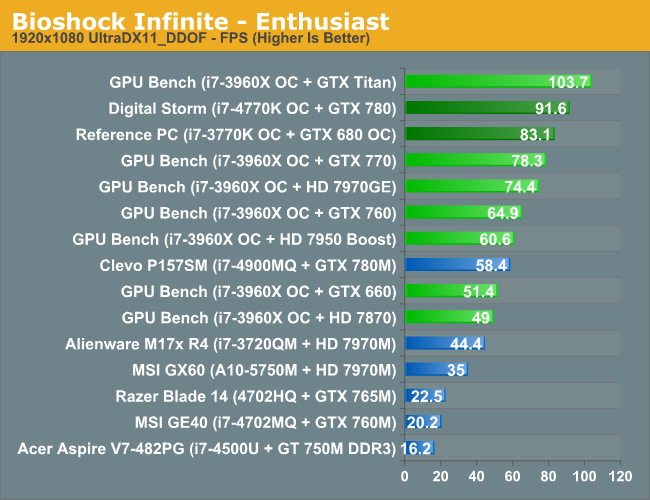
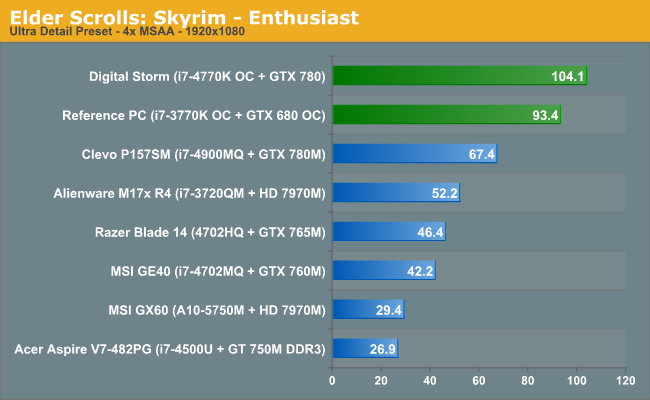
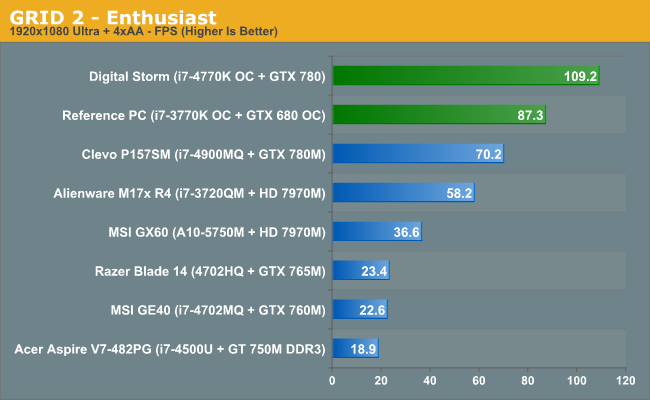


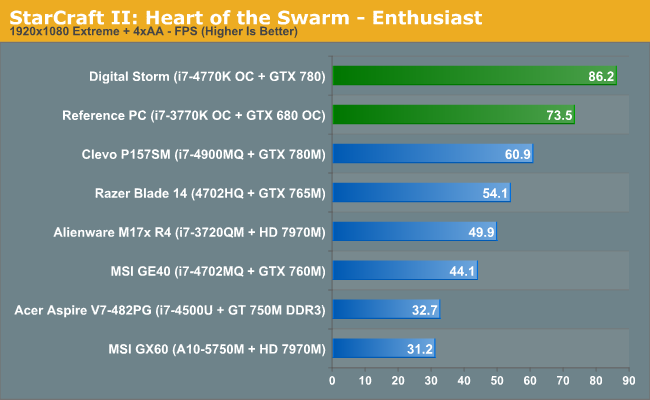
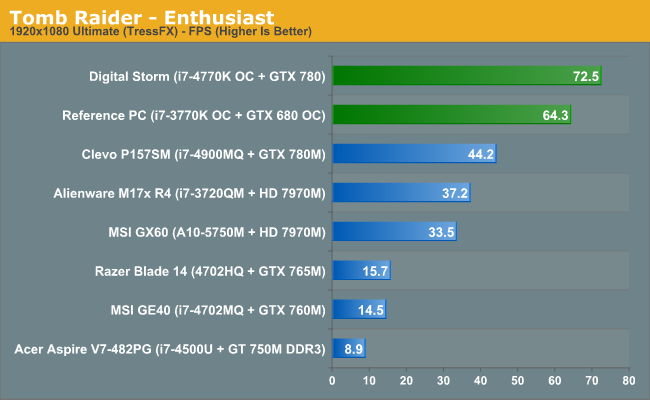
As far as replacing gaming desktop performance with a notebook is concerned, we’re nowhere near close to accomplishing this task. CPU requirements for the vast majority of users have reached a plateau during the past five or so years, but for graphics (games) we can still use pretty much all the horsepower available. The fastest mobile GPU we have right now, the GeForce GTX 780M, ends up delivering performance that falls roughly half way between the GTX 660 and GTX 760, or if we look at the Digital Storm system Dustin tested, it offers 60-70% of the performance of that desktop. Moving down to the lower performance mobile GTX parts like the GTX 765M, we haven’t tested any desktop GPUs in recent history that are anywhere near that slow – even the GTX 660 tends to be more than twice as fast as the GTX 765M and the GTX 560 Ti is still 50% faster. Drop one level further to the GT 750M (DDR3) and performance is about 60-80% of the GTX 765M! It’s not that you can’t game on a GT 750M or GTX 765M, but you’ll definitely need to drop the details down from max and turn off anti-aliasing. Finally, no matter what you do with a notebook, you’re not going to match the performance of the fastest desktop GPUs – the GTX Titan nearly doubles the performance of the GTX 780M, and even SLI GTX 780M isn’t likely to beat a Titan on a consistent basis.
Looking at pricing is also illuminating. Most notebook vendors charge around $650 (give or take) for a second GeForce 780M on the Clevo P370SM, compared to the desktop GTX 760 (which has slightly higher performance) that can be purchased for $250. Meanwhile, the desktop GTX 780M sells for the same $650 price as the GTX 780 while offering only 60-70% of the performance you get from the desktop GPU; the GTX 680 and GTX 770 have the same number of CUDA cores (1536) and go for $400, delivering superior performance at a substantially lower cost. The pattern continues as we move down the product stack; the slowest desktop Kepler, the GeForce GT 630, is a $65 card that has slightly higher clocks than the GT 750M, never mind the GT 730M and GT 740M, but the GT 730M is typically a $70 upgrade on a notebook. The GTX 765M has the same number of cores as the $130 GTX 650 Ti but with lower clocks; it reputedly sells for close to the same price to laptop OEMs as the desktop GTX 760 we mentioned as a performance equivalent of the GTX 780M.
Of course, where you can easily add a GPU to most desktops, with laptops you’re basically stuck with whatever you initially purchase. I noted in the Gaming Laptop Guide last month that the lowest price I could find for a notebook with a GTX 780M ends up around $1750 (including the OS with a 1TB HDD). For equivalent performance (more or less), we can take the desktop we listed above and add a GTX 760 GPU, with a slight PSU upgrade as well just to be safe. Here’s what we end up with:
| Mainstream Gaming Desktop PC | ||
| Component | Description | Price |
| CPU | Intel Core i5-4670 (Quad-core, 3.4-3.8GHz, 6MB L3, 22nm, 84W) | $200 |
| Motherboard | ASRock Z87 Pro3 LGA-1150 | $115 |
| GPU | GeForce GTX 760 | $250 |
| Memory | 2x4GB DDR3-1600 CL9 1.5V RAM | $65 |
| Storage | Seagate 1TB 7200RPM HDD | $70 |
| Optical Drive | SATA DVDRW (Lite-On) | $18 |
| Case | Antec Three Hundred | $60 |
| Power Supply | Rosewill Green RG530-S12 530W 80 Plus Bronze | $55 |
| Operating System | Windows 8 64-bit (OEM) | $100 |
| Total | $933 | |
Opting for a gaming notebook thus carries a hefty price premium, nearly doubling the price of a similar performance desktop. Yes, the notebook still gives you a battery, display, keyboard, touchpad, and speakers as part of the package, but if you already have those for an existing desktop they’re not really necessary. The price premium for high-end gaming notebooks has certainly come down from the 2x-3x we used to see (though you can still get to that range with SLI notebooks), but we’re nowhere near parity like we are on the CPU side of things. As an alternative, desktop GPUs are also able to hit much higher performance levels at a similar cost to a high-end gaming notebook.
Given the various options, many people have concluded that it’s far better to have a decent gaming desktop like the one above and then to spend another $500-$1000 on a good laptop for when you need to go mobile. That’s generally my recommendation as well – for all the gaming notebooks I’ve reviewed over the years, I still turn to my desktop system 95% of the time when I’m looking to play a game. On the other hand, not everyone wants to worry about having two computers and syncing data between them, and there are also space limitations to consider. Finding a spot for a 10 pound gaming notebook in a college dorm is easy enough; finding space for a gaming desktop with display, speakers, keyboard, and mouse can be a bit more difficult. And if you’re regularly on the road and want to take your games with you, you’ll need the laptop regardless.
There’s no right answer for how to do things, of course. Some people love gaming notebooks and others don’t see the point. But while you can certainly make a case for typical notebooks/laptops now being close to price parity with similar performance desktops, once you add gaming into the mix you’ll need to pay the mobility piper his due.










110 Comments
View All Comments
WiSH2oo0 - Wednesday, September 11, 2013 - link
Cheers Garrettino and have a good day!carage - Saturday, September 7, 2013 - link
If the laptop has an ExpressCard slot (hint: business laptops or mobile workstations) or Thunderbolt port you could settle for a high CPU model regardless of whatever GPU comes with the laptop and go the external route. There are some additional costs to this expansion, like you would likely need connectors and/or enclosures that run from $100 ~ $900 (Thunderbolt Enclosure), and the cost of whatever desktop card you want (nVidia recommended due to Optimus Compression technology). Even then there will still be performance penalties, because the external port bandwidth is nowhere near PCI-E 16X. But after these upgrades, a $1500 laptop with a GTX 670/680 can still take on a $3000+ monster gaming laptop.nerd1 - Saturday, September 7, 2013 - link
Sony vaio Z already tried the thunderbolt external GPU idea and it sucked.1. bandwidth is so limited so it's total waste of GPU power.
2. Thunderbolt enclosures are terribly expensive, and it make more sense to just build another desktop than use them, unless you are forced to (like new mac pro)
mapurisa - Saturday, September 7, 2013 - link
The Vaio Z used a midrange mobile GPU instead of a high performance desktop GPU which completely defeated the purpose.The technology isn't perfect by any stretch but for a significant portion of the market this would be a good solution but there's no incentives for the AMD/Nvidia to make it happen. Intel being the only non-GPU (in the traditional sense) manufacturer is happy with the current state of affairs ; it can play the same overcharging game for its Iris Pro chips without losing any marketshare or profits.
Meanwhile Thunderbolt withers on the vine and consumers get the shaft.
nerd1 - Saturday, September 7, 2013 - link
Yes it used midrange mobile GPU, and the performance drop was already like 50%.With higher performance GPU the performance drop due to bottleneck will get even higher.
digitalgalt - Saturday, September 7, 2013 - link
I use a ViDock loaded with an EVGA 760 Ti tied to my Lenovo T520 (with only Intel HD3000 integrated graphics) and it basically demolishes all games at 1920x1200.I don't even want to try Crysis 3 on it, that is well past the Express Port choke point. But for a hard metric, I can run Fable 3 and the Witcher 2 at 1920x1200 with all settings to ultra, around 30-35 frames per second.
nerd1 - Saturday, September 7, 2013 - link
If you can be satisfied at 765M performance (which can run most titles at 1080p with medium settings) actually laptops are cost effective. Also laptops are pretty much a must nowadays especially for university students, so it still is cheaper to have $1800 laptop than $800 ultrabook and $1200 desktop.Impulses - Sunday, September 8, 2013 - link
Not much cheaper tho, and the desktop is easier to upgrade... I think you can easily make an argument for going either way, it ultimately comes down to personal preference and other intangibles... i.e. Are you gonna game while on the go or would you rather have a lighter laptop? Do you even have space for a desktop or would you actually benefit from having two discrete systems? Etc etc.purerice - Sunday, September 8, 2013 - link
Agreed with impulses on it not being cheaper. That desktop is more like $1100, but if I had that, why would I need an ultrabook? I completed post-grad with a $1000 desktop and $400 laptop. An ultrabook would have been a tacky fashion statement.Getting a new CPU/GPU for Anand's reference PC would be $450. To get that same new CPU/GPU in that laptop, you'd need to spend $1800 again.
brucek2 - Saturday, September 7, 2013 - link
I think this is my first time seeing the AMD Center branding on an article (I'm guessing because it has an AMD tag?) I've got no objections to the concept, but boy is that red text and red button background unattractive. On my monitor I'm not sure it even matches Radeon red branding (could be by monitor's lack of calibration of course)?Maybe there's a way AMD could could get some custom vertical elements or something while the site sticks with the standard colors for the main article text and controls?